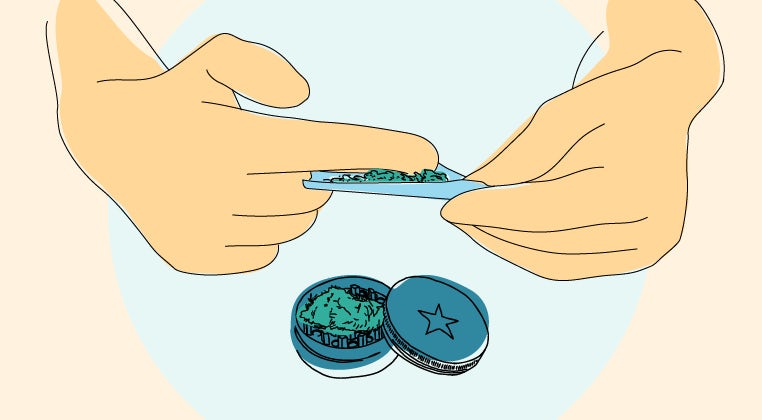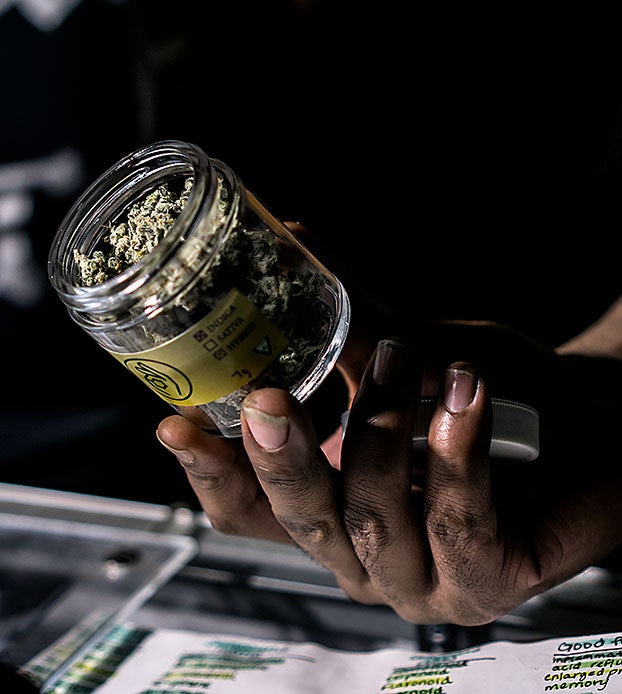It’s conventional wisdom that’s been passed down for generations and is accepted as de facto gospel among marijuana smokers — the longer you hold the smoke in your lungs, the stronger the effect. And while holding your breath and taking strong, deep inhalations can produce a stronger feeling, research has found that the longer you wait before exhaling has no bearing on the actual absorption of THC — the psychotropic component in marijuana.
Part of the popularity of smoking as a delivery method is that with marijuana it produces an almost instant effect, as the smoke is absorbed into the tiny air sacs in the lungs, known as alveoli. The exposure to heat during smoking and vaping also decarboxylates the marijuana, converting the THCA to THC as the smoker pulls it into their lungs.
Like with so much else involving marijuana, the key to the intoxicating effect is how much of the THC makes it into our blood; this is what is known as bioavailability. With THC, bioavailability is closely linked to the method of consumption, and a major part of why smoking, and inhalation in general, is such an effective and popular way to consume marijuana.
A 2007 article stated that on average, THC has a bioavailability of 10-30% when smoked, while oral ingestion of THC (edibles, for example) has an average bioavailability of only 4%-12%. Another study in 1980 tested 11 healthy subjects who took THC intravenously, smoking, and by mouth. The smoking and IV had similar bioavailability, but the plasma level of THC after oral doses were low and irregular, indicating slow and erratic absorption with oral consumption. For cannabidiol (CBD), the non-psychoactive cannabinoid used for treatment, research has shown that the same general principles applies — smoking produces a much higher and faster bioavailability than oral dosing. 1
Furthermore, a 2006 study found that a vaporizer could deliver an average of about 54% of the THC loaded into it and that on average 35% of inhaled THC was directly exhaled again, results that are comparable to smoking. 2
But does holding your breath actually make a difference in the effect of marijuana? And is that net effect worth any negative effects that could come from holding the smoke in for longer?
Probably not, at least according to the limited research on the topic.
A study carried out in 1989 observed eight regular marijuana smokers as they held marijuana smoke in for durations of 0, 10, and 20 seconds. The researchers tested a variety of parameters including increased heart rate, increased “high” and impaired memory performance according to each duration and found “there was little evidence that response to marijuana was a function of breath hold duration.”
This is consistent with the findings of a study performed two years later that examined the effects of marijuna on 10 regular smokers who inhaled for breath hold durations ranging from 0 to 20 seconds. The researchers found that the “effects of marijuana on mood were not consistently affected by breath hold duration,” and that prolonged breath holding “does not substantially enhance the effects of inhaled marijuana smoke.”
While this doesn’t make a lot of sense logically, there is some science behind it. During smoking there are a lot of smoke byproducts being produced – this is why smoking smells so much more than vaping. Many of these small particles are not cannabinoids or terpenes, but rather tiny, harmful particles known as aromatic hydrocarbons. These are abundant in cannabis smoke and carry numerous health risks, including contributing to lung cancer. 3
When scientists evaluate the smoke produced from burning cannabis, they find numerous similarities to tobacco smoke. Within Type I cannabis (marijuana) smoke, scientists identified hundreds of combustion byproducts and carcinogens that are also found in tobacco smoke. 4
The same scientists did note some apparent differences in cannabis smoke versus tobacco smoke – namely around the size and mass (weight) of the particulates). The smoke particulate produced when cannabis is burnt produces larger and heavier particulates, which would result in a more rapid settling compared to lighter smoke particles which would linger in the air (lungs) for longer.
Therefore the premise of holding in smoke is flawed by the fact that the cannabinoids are generally delivered to the target tissues (the lungs) in the first handful of seconds after a hit, and holding in the hit does not correlate with increased absorption of THC.
Research is one thing though, and anecdotal evidence carries a lot of weight, including among marijuana smokers. So why does it feel like holding your breath makes the effect stronger? This could be simply that you are holding in the small, harmful smoke particles for longer, depriving your brain of oxygen, producing a more of a lightheaded feeling. Additionally, if you’re smoking marijuana mixed with tobacco, you will also be feeling the effect of the nicotine.
Is holding in smoke bad for you?
While it is commonly said that the longer you hold smoke, the higher you get, that argument has not yet been shown to be true despite the fact that it is logical. But what has been shown to be true is that exposure to small particles in smoke can be harmful to the lungs. We also know that these small particulates linger in the air as smoke/vapor, while heavier cannabinoid molecules fall more quickly. In other words, holding the smoking in the lungs has diminishing returns, because at some point there is very little cannabinoid being absorbed, but there is substantial exposure to these microscopic harmful particles.
And while there are certainly concerns around inhalation of smoke and of additives used in vapes, to date there is no high quality evidence that smoking cannabis alone leads to lung cancer. It appears that the effects of tobacco and cannabis are very different in the lungs. 5
What does make a difference?
There are a number of factors that can affect the strength of your marijuana when smoking. These can include the amount of marijuana smoke you take in with each inhalation, and also, according to one study, the depth of the inhalation.
Basically, it’s not so much how long you hold the inhalation in, rather how much smoke you pull in. While inhaling, smoke can escape by way of side-stream loss, a strong breeze, coughing, or — if mixing with tobacco — taking an inhalation of a portion that includes more tobacco than marijuana. This would explain why the bioavailability of THC when smoking can vary greatly and be linked largely to user experience and ability. In other words, chronic cannabis users absorb more because they have optimized their inhalation, rather than how long they hold it in.
Logically could there be more absorption of cannabinoids by holding in smoke, sure. But considering the contents of the inhalation are most cannabinoid-rich in those first few seconds, and that the rest of the smoke contains inflammatory and cancer causing particulates, holding the smoke in increases the total exposure to these particulates, which is surely bad for the lungs. Overall the benefits of holding the smoke just don’t outweigh the potential downside.
And while it’s true that the effects are felt almost instantly after smoking, it will take a few minutes for the effect to creep up on you, and up to 15-30 minutes to feel the full effects. Take your preferred strain of cannabis, find a comfortable spot, take your time, and breathe easy. There’s no need to hold your breath.
Sources
- Lucas CJ, Galettis P, Schneider J. The pharmacokinetics and the pharmacodynamics of cannabinoids. Br J Clin Pharmacol. 2018;84(11):2477-2482. doi:10.1111/bcp.13710
- Hazekamp A, Ruhaak R, Zuurman L, van Gerven J, Verpoorte R. Evaluation of a vaporizing device (Volcano) for the pulmonary administration of tetrahydrocannabinol. J Pharm Sci. 2006;95(6):1308-1317. doi:10.1002/jps.20574
- Wei B, Smith D, O’Connor R, Travers MJ, Hyland A. Examining the Association between Body Burdens of Harmful Chemicals and Heaviness of Marijuana Smoking. Chem Res Toxicol. 2018;31(8):643-645. doi:10.1021/acs.chemrestox.8b00160
- Graves, B.M., Johnson, T.J., Nishida, R.T. et al. Comprehensive characterization of mainstream marijuana and tobacco smoke. Sci Rep 10, 7160 (2020). https://doi.org/10.1038/s41598-020-63120-6
- Melamede, R. Cannabis and tobacco smoke are not equally carcinogenic. Harm Reduct J 2, 21 (2005). https://doi.org/10.1186/1477-7517-2-21
Sign up for bi-weekly updates, packed full of cannabis education, recipes, and tips. Your inbox will love it.

 Shop
Shop Support
Support



















